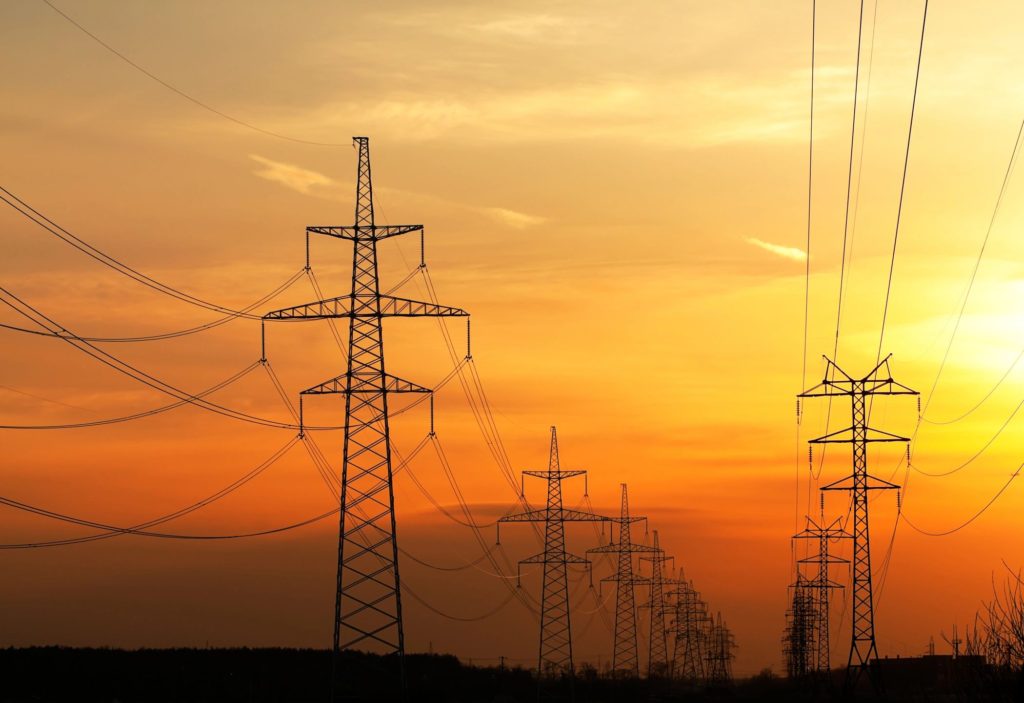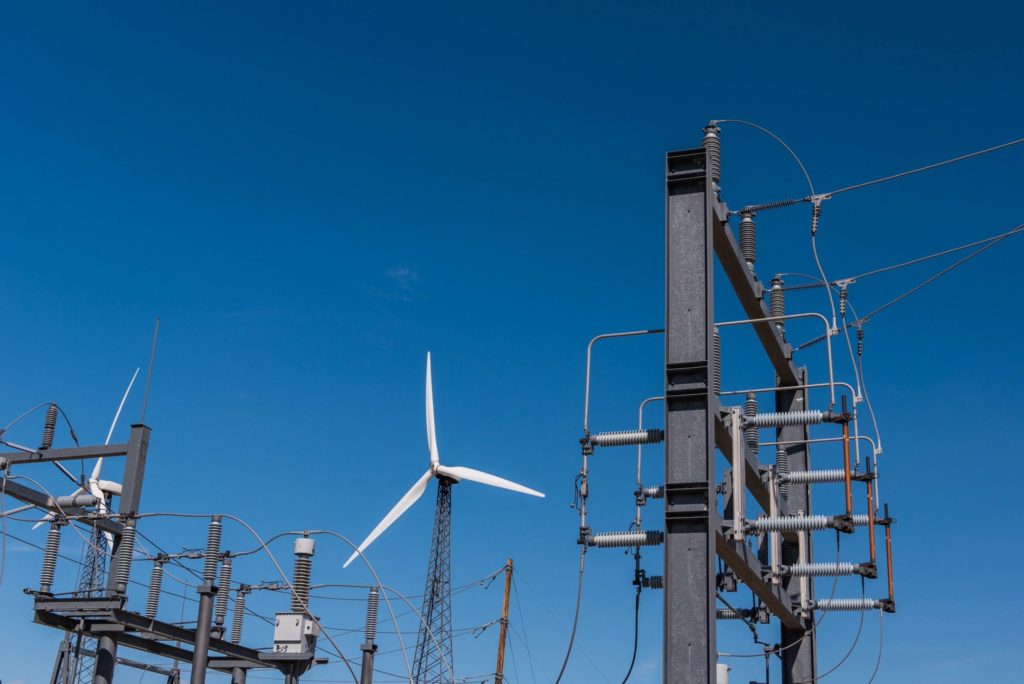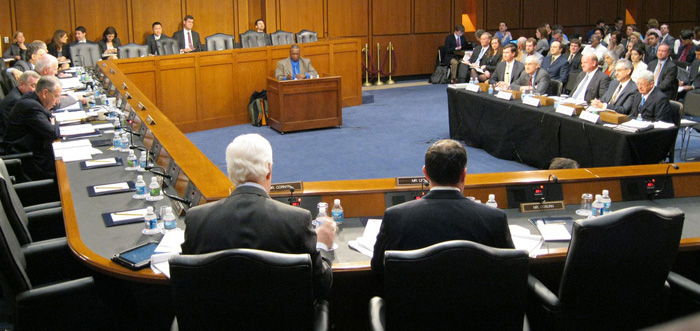
Blog: Energy Infrastructure in the Trump Presidency
While large-scale energy projects seem inconsequential to local family businesses, the unpredictability of a volatile energy market can financially squeeze these vital contributors to our economy. Yesterday, President Trump spoke to a crowd at the Rivertown Marina in Cincinnati, Ohio about his long-awaited infrastructure plan, providing a broad outline of his priorities. In addition to reducing permitting time for projects from 10 years to 2 years and “slashing regulations to speed up the decision-making process,” Trump has made overtures to enhance infrastructure in the energy sector. While specifics have remained scarce, the president has made clear his commitment to eliminating burdensome rules hindering oil and gas exploration.
The Rivertown comments come after Trump’s nominations of Robert Powelson, and Neil Chatterjee to FERC in May. Progress on several natural gas pipeline projects was stalled by the lack of a quorum, causing a number of energy groups to prod the President to fill the positions at FERC. Now, the commission has $50 billion in energy projects to address and is working through proposals to reform wholesale power market structures. Another large component of President Trump’s $1 Trillion plan is the completion of the Keystone XL and Dakota Access pipelines, which he cited as examples of his administration’s commitment to strengthen America’s energy infrastructure. “Nobody thought any politician would have the guts to approve that final leg,” Trump said. The White House statement indicated that Trump will dedicate $200 billion in his budget this year to energy infrastructure. The completion of these energy pipeline projects will bring welcome relief to small, family-owned businesses.
Improving America’s energy infrastructure can help to reduce energy costs for family businesses by making it easier for energy resources to come to market. Transporting crude oil via pipeline reduces the cost of transportation by 50-60 percent compared to rail transport. In addition to energy transportation infrastructure, the development of more energy efficient electrical grids will also reduce the cost of energy for family businesses across the country. As we begin to overhaul and expand our energy infrastructure it is important that we do so in a way that helps reduce energy costs prepares us for the future ways we will use energy.

Blog: President Trump’s budget supports affordable energy
On Tuesday, President Trump released his 2018 budget. While the President’s annual budget usually isn’t enacted into law, it provides an important blueprint of where the administration will be focusing its efforts. If ratified, president Trump’s proposal would fulfill several key campaign promises, namely, the increasing funding for energy production, defense, and homeland security initiatives.
From an energy perspective, the President placed the highest priority on reducing energy costs and developing America’s natural resources, stating “A consistent, long-term supply of lower-cost American energy brings with it a much larger economy, more jobs, and greater security for the American people.” In addition to relaxing offshore drilling restrictions, the administration’s budget document includes a plan to open Alaska’s Arctic National Wildlife Refuge (ANWR) for oil drilling by 2022. Such a plan, if enacted, would raise $1.8 billion by 2027.
The Department of Energy faced reductions under the President’s budget, with cuts of $3.1 billion, or 18 percent. One component of that cut is the largely bipartisan federal renewable energy program known as the Advanced Research Projects Agency—Energy, or ARPA-E. A hallmark of bipartisan cooperation since it was created less than a decade ago, ARPA-E was launched under President George W. Bush as part of a broader package to encourage American innovation.
Fortunately for the President, several congressional Republicans are already on board with many his priorities, eager to roll back the preceding administration’s activism. Arizona Representative Paul Gosar commented, “Kudos to the Trump Administration for reducing bureaucratic blight within the EPA by supporting a true all-of-the-above energy strategy and providing much-needed relief to rural communities and local stakeholders.”
One idea that some Congressional Republicans are less excited about is the President’s proposal to sell off half of the Strategic Petroleum Reserve. Another revenue raiser for the federal government, the budget predicts sales would raise $16.5 billion over 10 years. However, many on the right are anxious about the national security ramifications of such a plan given the unstable geopolitical climate.
Ultimately, the President’s budget is interpreted by Congress as a strong suggestion. We will likely see Congressional appropriations bills that will reflect many of his energy priorities.

Rooftop solar has hidden risks for consumers and family businesses
By Alex Ayers
Recently rooftop solar panels have been promoted to Alabama residents as a way for energy consumers to lower their electrical bills, however there are still many risks involved that oftentimes may outweigh the benefits.
Rooftop solar panels have increased in use in recent years, 18 gigawatts of solar photovoltaics were installed between 2008 and 2014 nationwide. At this growth rate rooftop solar will play a part in supplying American consumers with electricity in the future, and Family Businesses for Affordable Energy promotes diverse energy sources because competition helps to keep energy prices affordable.
However, if growth continues before hidden costs are dealt with, it has the potential to have major impacts on the affordability of electricity for family businesses and households.
The largest growth in rooftop solar panels has come from states that mandate the price that consumers are paid to sell excess solar energy back to the grid through a policy known as net-metering. Alabama solar users currently can sell their excess power to their utility company when they are not using all of the generated power themselves at market rates instead of state mandated rates. The rates at which utilities pay consumers for the electricity vary by state, but those states that mandate retail prices shift the cost burden of maintaining the grid away from solar users to non-solar consumers. This increases the cost of electricity on low-income users and renters who cannot afford or are not allowed to install their own rooftop solar panels.
For non-solar consumers in Nevada this means an increase of $600 per year to subsidize rooftop solar users. In states where net-metering is poorly regulated it creates a regressive income transfer from those who cannot afford solar to those who can. For utilities that transfer the costs from households to commercial customers, the increased overhead cost is passed on to the consumer through increased product prices, either way consumers lose out in poorly regulated net-metering schemes.
Alabama has so far successfully stayed away from these regressive policies, buy could see pressure to change in the future.
As rooftop solar becomes more popular, it opens up the market to bad actors that try and take advantage of consumers interested in lowering their electrical bills. For consumers leasing solar panels there are often hidden costs associated with maintenance and upkeep of the panel that are not easily identifiable in the the leasing agreement.
Some companies require lessees to contract with another company to clean and maintain the panels at costs of up to $700 per year. With long-term leases of 15-20 years these requirements significantly increase the payback period of the solar panels. The leases also make moving more difficult as the leaseholder can put a lien on the entire property claiming it is necessary to protect the solar panels. Additionally, installing solar panels can increase the assessed value of the home and therefore increase the property taxes paid by the consumer.
In addition to hidden costs, some bad actors have used solar installations to scam consumers. In 2015 an Arizona judge released more than 1,000 customers from their leases from a predatory company that failed to install nearly three-quarters of the units and withheld state payments owed to customers.
In other states predatory companies can install panels claiming the cost to the homeowner will be significantly lower than buying electricity from the utility company, but when utility rates remain steady, the rates charged by the solar installer increase over time costing the homeowner more than if the panels had never been installed. As solar becomes more popular, stronger consumer protections will be needed to stop predatory companies like these.
Recent improvements in efficiency and decreasing costs of production will make rooftop solar an ever larger producer of electricity in America, however Alabama lawmakers should stay vigilant in future policymaking to ensure that the hidden costs are not shifted to non-solar users, especially low income consumers who cannot afford higher electric bills. Smart policies can protect all consumers and help make energy more affordable.
Alex Ayers is the executive director of Family Businesses for Affordable Energy (FBAE). FBAE launched the Make Solar Safe initiative for consumers and policymakers to better understand how to protect solar power customers from predatory companies, unsafe construction, and other hazards.
Read original at: http://www.al.com/opinion/index.ssf/2017/05/rooftop_solar_has_hidden_risks.html

Tax credit has helped create a robust industry in New Mexico, report says
By Christopher Ortiz
New Mexico has benefited from its renewable energy production tax credit, which has supported more than 11,000 jobs and represents $1.6 billion in economic activity, according to a new report.
The report, released by Family Businesses for Affordable Energy this week, says the state has established has “a robust renewable energy generation sector with enormous potential for growth” and clean power is a wise investment for New Mexico. The credits are set to expire next year.
Over 13 years, $120 million in renewable energy production tax credits have been claimed. New Mexico has seen 13 commercial wind facilities with a capacity of 1.1 gigawatts and 46 solar photovoltaic facilities with a capacity of 452 megawatts come online. According to the report, power producers that have taken advantage of the renewable energy production tax credits have spent $1 billion in the state constructing, equipping, operating and maintaining 31 generation facilities. For every $1 in state tax expenditure, these projects generated $5 in labor income, the report claims. The report points out that the tax credits are not the only factor considered in where and when renewable energy facilities are built.
According to the Santa Fe New Mexican, proposed legislation would extend the renewable energy tax credits through 2023. The legislation would also raise existing caps on the amount of renewable energy production eligible for the credits.
O’Donnell Economics and Strategy prepared the report for Family Businesses for Affordable Energy, which says it supports policies that lower energy prices for small businesses. Data for the report came from the New Mexico Energy, Minerals and Natural Resources Department. A 2015 report from the same department found that for every 14 cents in tax expenditure, renewable energy production tax credit projects generated $1 in labor income.
http://www.bizjournals.com/albuquerque/news/2017/03/08/tax-credit-helped-renewables-nm-report-says.html

New Mexico’s Wind/Solar Tax Credit Works New Study Finds 11,700 New Jobs, $1.6 Billion Created
Family Businesses for Affordable Energy (FBAE) today announced a new economic impact study, finding that New Mexico’s solar/wind tax credits have created more than 11,700 jobs, $1.6 billion in economic activity and more than $600 million in new labor income.
The FBAE analysis estimated the economic impact of New Mexico’s Renewable Energy Production Tax Credit (REPTC) and now represents the most current research on the subject. The REPTC, originally implemented in 2003, is a credit against New Mexico personal or corporate income tax that is available to companies that produce electricity from renewable resources for commercial sale.
“These tax credits are a phenomenal success for New Mexico,” said Palmer Schoening of the FBAE. “Taxpayers are getting a huge return on their investments in clean energy – new jobs, new investments, new economic activity –while reaping the additional environmental benefits that come from clean energy. This is a win-win-win situation for taxpayers, consumers, and businesses throughout New Mexico.”
Findings of the study include:
- A total of $120 million in Renewable Energy Production Tax Credits have been claimed over the past 13 years. During that time, New Mexico has made significant progress in developing its wind and solar power capacity, gaining 13 commercial wind facilities with nameplate capacity of 1.1 gigawatts and 46 solar photovoltaic (PV) facilities with nameplate capacity of 452 megawatts.
- During that time, REPTC-certified power producers have spent over $1 billion in New Mexico to construct, equip, operate, and maintain 31 generation facilities. Expenditures by REPTC-certified power producers have supported 11,771 full and part time jobs, $611 million in employee compensation, and $1.6 billion in economic activity statewide.
- For every $1 in state tax expenditure, REPTC-certified projects generated over $5 in labor income.
- These economic impacts have generated state and local tax revenue totaling $74.6 million and averaging $6.8 million annually.
Palmer called for the extension of the REPTC, an extension that will lead to more new jobs and investments, while helping to lower the cost of energy for families and businesses. The REPTC is set to expire January 1, 2018. A bipartisan bill (HB440 and SB432) changes and temporarily extends the program. The goal: to support continued investments in New Mexico while also adjusting the tax credit itself to better reflect the decreased costs of building renewable energy facilities.
In addition, the bill provides a more appropriate end date for the program, phasing out the production tax credit by 2023—as opposed to ripping the rug out from under companies already invested as well as the ones on the waiting list.
“New Mexico has made great progress in renewable energy since implementation of these tax credits,” he said. “Our study proves beyond any doubt that for every dollar you invest, New Mexico gets $5 dollar back in labor income, thousands of new jobs and billions in new investment. Solar and wind done right reaps great benefits for New Mexico, and New Mexico has been doing it right.”
O’Donnell Economics and Strategy conducted the study. Kelly O’Donnell is an economist and research professor at the University of New Mexico Institute for Policy, Evaluation, and Applied Research. Her specialties include regional economic development, economic impact analysis, and state fiscal policy. Prior to academia, Dr. O’Donnell held a series of leadership roles in New Mexico state government including Director of State Tax Policy, Deputy Cabinet Secretary for Economic Development, and Superintendent of the New Mexico Regulation and Licensing Department. She holds a PhD in Economics from the University of New Mexico.
O’Donnell can be reached at 505-659-5702 or [email protected].
Schoening can be reached at 202-787-1399 or [email protected]

Continuing New Mexico Tax Credit for Wind/Solar Program Will Create New Jobs, Billions in Investments
Family Businesses for Affordable Energy (FBAE) today called for the extension of the New Mexico Renewable Energy Production Tax Credit (REPTC), an extension that will lead to more new jobs and investments, while helping to lower the cost of energy for families and businesses.
With this simple incentive, New Mexico already created thousands of jobs with billions in new investments. According to a recent study commissioned by the NM Energy, Minerals & Natural Resources Department, the tax credit created over 9,000 jobs, $430 million of labor income, and reductions in electricity costs—numbers that significantly exceed the fiscal cost of the tax credit.
Conservative estimates are that there is $1.5-$2 billion worth of investments on the current solar waiting list alone. This could translate into 7,000-9,000 new jobs for New Mexico just waiting for the tax credit extension.
“New Mexico should continue to invest in its energy infrastructure,” said Alex Ayers, Executive Director of FBAE. “Taxpayers will get a huge return on new jobs, new companies, and projects that are already in the pipeline, just waiting to get started if this credit is continued. We cannot allow these potential jobs to just be thrown away or to leave New Mexico for other states with tax credits.”
“These tax credits are good for family businesses, good for taxpayers and good for the New Mexico economy,” he said.
In 2002, New Mexico expanded its renewable energy sector, bringing jobs, investments and sustainable energy into the state. To help spur private investments, the legislature implemented the REPTC—a tax credit available to energy companies who generate electricity from renewables, such as solar arrays and wind turbines.
This incentive program is set to expire January 1, 2018. A bipartisan bill (HB440 and SB432) changes and temporarily extends the program. The goal: to support continued investments in New Mexico while also adjusting the tax credit itself to better reflect the decreased costs of building renewable energy facilities.
In addition, the bill provides a more appropriate end date for the program, phasing out the production tax credit by 2023—as opposed to ripping the rug out from under companies already invested as well as the ones on the waiting list.

Family Businesses for Affordable Energy Launches Website Promoting Safe Solar for Businesses, Families
Family Businesses for Affordable Energy today launched a new website for consumers and policymakers to better understand how to protect solar power customers from predatory companies, unsafe construction, and other hazards. The website, which can be accessed at www.MakeSolarSafe.com, shows how consumers have been affected by bad actors in the solar industry and offers ways government can help protect owners of solar panels.
“As the use of solar technology grows nationwide, it is critical that both the public and policymakers have solid information about the dangers posed by solar panels if customers aren’t properly protected,” says Alex Ayers, Executive Director, Family Businesses for Affordable Energy. “This new website helps make sure that information is available to everyone and aims to provide balance to the conversation about solar power deployment.”
The website allows consumers who have solar horror stories, either from fraudulent contractors or unsafe installations, to share their stories online. Those considering purchasing solar systems can read previous horror stories and learn ways to protect themselves from the same mistakes. Legislators using the website have access to best practices and solutions that will protect their constituents from possible dangers.
Examples of the content available at MakeSolarSafe.com includes stories about solar customers in Arizona and California who were defrauded by contractors, a small business in New York that caught on fire from faulty installation, and the dangers improperly installed panels cause for firefighters and first responders. Stories such as these are intended as cautionary tales to educate consumers and help prevent these actions from happening again.
The website also outlines legislative solutions for policymakers including preventing fraud, keeping costs low for all customers, and implementing ways to protect firefighters and first responders when solar panels are present. Family Businesses for Affordable Energy supports an “all in” approach to energy sources, including solar power, but also believes in safety and security for all consumers of energy.
Family Businesses for Affordable Energy (FBAE) is a network of family businesses across the country supporting policies that lower energy prices for small businesses. Consistently a top cost that family business face is the price of energy, both utility and fuel costs. FBAE supports common sense policy solutions on the federal and state level that reduce the cost of energy for small businesses.

Family Businesses for Affordable Energy sent letters of support for EPA Nominee Pruitt to committee
Today, Family Businesses for Affordable Energy sent letters of support for the nomination of Scott Pruitt to be Administrator of the Environmental Protection Agency. Mr. Pruitt has been a vocal supporter of commonsense regulation that will protect the environment and allow businesses to thrive.
In recent years the EPA has over-regulated family businesses far beyond their mission of protecting America’s air and water. We plan to work with Mr. Pruitt to roll back overzealous regualtions and implement smarter rules to protect the environment.
Read the letters here:

